Site menu:
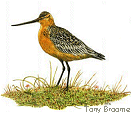
June 2010 Newsletter
Colour Ringed Knots.
May Bird News.
Forthcoming Events.
Latest Newsletter.
Colour Ringed Knots
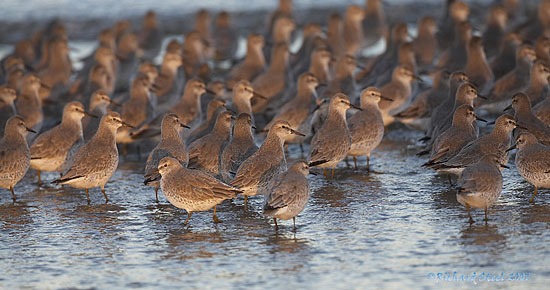
Although numbers can vary greatly from day to day, let alone from winter to winter, the Knot is generally regarded as one of the most numerous waders on the Dee Estuary and North Wirral coast. Globally, there are six sub-species of Knot but, apart from the odd vagrant, we only get Calidris canutus islandica here. These winter almost exclusively on the Wadden Sea and estuaries of the British Isles with smaller numbers on the north and west coasts of France. They breed in Greenland and north-east Canada. It is thanks to ringing that we know all this, and colour ringing in particular has transformed our knowledge of this species.
The movements and migrations of birds has always fascinated me and it is particularly pleasing that, thanks to colour ringing, myself and some like minded enthusiasts have been able to contribute in a small way to the sum of this knowledge, as well as being able to find out within a matter of days the movements of particular birds we have observed.
The winter just gone, 2009/10 was a particularly good one for ringed knots as we were able to record eight, bringing the total since 2006 to 11 - they are tabulated below in order of ringing date.
| Knot No. | Date Ringed | Ringing Location | Date seen on Dee Estuary | Location |
|---|---|---|---|---|
| 1 | 12/6/03 | Alert, Ellesmere Island, Canada | 11/12/07 | Hoylake Shore |
| 2 | 23/7/04 | De Richel, Wadden Sea, Netherlands | 20/12/06 | Meols Shore |
| 3 | 23/7/04 | De Richel, Wadden Sea, Netherlands | 20/2/10 | Thurstaston Shore |
| 4 | 10/3/05 | Griend, Wadden Sea, Netherlands | 5/3/10 | Hoylake Shore |
| 5 | 23/8/06 | Simonszand, Wadden Sea, Netherlands | 12/2/10 | Thurstaston Shore |
| 6 | 16/5/07 | Porsangerfjord, north Norway | 12/2/10 | Thurstaston Shore |
| 7 | 18/5/07 | Stufhusen, Wadden Sea, Germany | 9/1/10 | Thurstaston Shore |
| 8 | 7/6/07 | Alert, Ellesmere Island, Canada | 12/2/10 | Thurstaston Shore |
| 9 | 27/9/08 | Schiermonnikoog, Wadden Sea, Netherlands | 1/11/08 | Hoylake Shore |
| 10 | 27/9/08 | Schiermonnikoog, Wadden Sea, Netherlands | 12/2/10 | Thurstaston Shore |
| 11 | 26/5/09 | Porsangerfjord, north Norway | 20/2/10 | Thurstaston Shore |
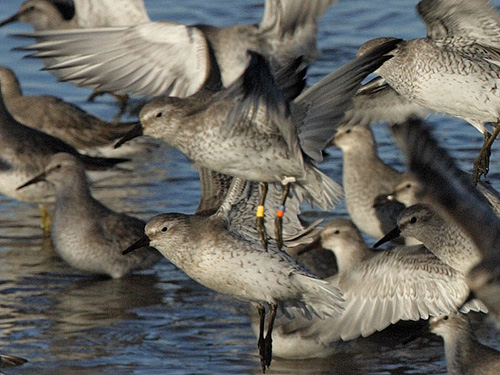
The colour ringed bird above (© Steve Round) is Knot number one in the table above. Note the white 'flag' high up on the left tibia which denotes it as being a Canadian ringed bird.
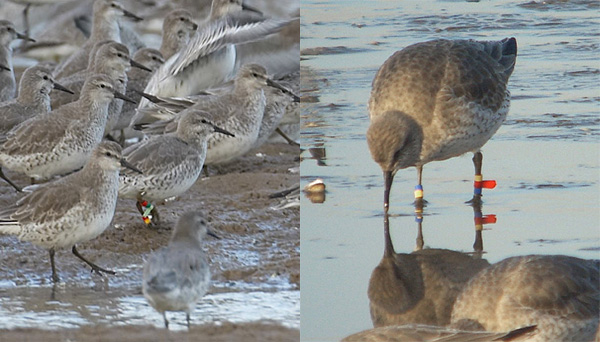
The left photo shows Knot number nine (© Richard Steel) and the right photo is of Knot number two (© Richard Smith).
The two maps below show the locations where the 11 different birds were ringed, seven of which were on the Wadden Sea. This is a huge area stretching from the island of Texel (just north of Amsterdam) all the way to south west Denmark - it's the equivalent of having six Washes strung together - and is hugely important for numerous wader and wildfowl species, particularly as a moulting area. It must be a wonderful place to both watch and ring birds; for example, Griend (where bird four was ringed) is an uninhabited island and nature reserve which has 10,000 pairs of Sandwich terns nesting!
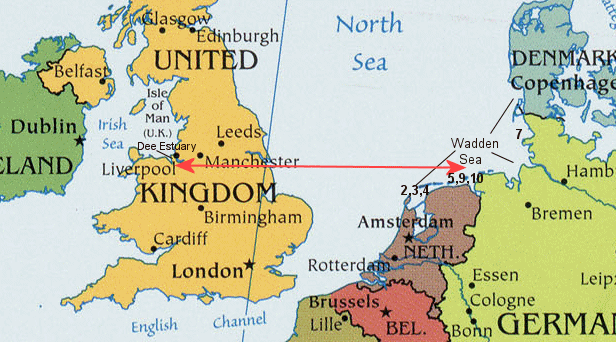
The map below shows the routes which C c islandica birds take during the spring migration - details of which have been established due to ringing. The total population of islandica is currently estimated to be around 400,000, about 70% of these move to the Wadden Sea to moult around mid-March, the rest staying in large British estuaries such as the Ribble and the Wash. They stay here until late April or early May when they then move to staging areas which are in Iceland and northern Norway. They then stay at these staging areas for about three weeks before finally moving to their breeding grounds in Greenland and Canada. When I first realised that some of 'our' birds go via northern Norway I though that it seemed a long way round to get to Canada but for birds breeding on Ellesmere Island, for example, it is actually an easier route as it avoids the birds having to fly over or around Greenland. As you can see at least some of our birds do use this Norway route, and two were ringed at Alert in Canada, just five hundred miles from the North Pole!
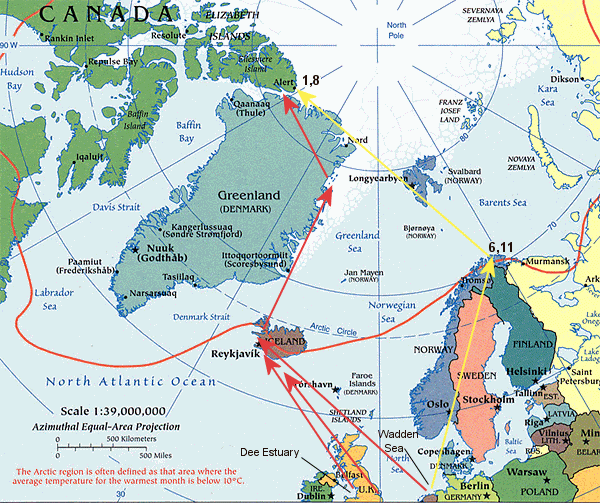
Maps kindly provided by University of Texas Libraries (arrows, numbers etc. added by the author).
Sources of information for this article:
1. Fellow colour ring enthusiasts John Jakeman and Matt Thomas, and
photographers Steve Round and Richard Steel.
2. Bernard Spaans (Netherlands), Jim Wilson (Norway) and Guy Morrison
(Canada) - thanks in particular to these three for being so prompt with
their ringing data plus a lot of extra and very interesting information,
and everyone else involved in the Knot colour ringing schemes.
3. Simon Delany et al., An Atlas of Wader Populations in Africa and
Western Eurasia, Wetlands International, 2009.
Please me if you see a colour ring Knot, or any other wader, usually I can get the data back to you within a week or two. Note that all the Knots have flags (rings with tabs) and it is very important to note the location of the flag in relation to the other rings. Norway ringed birds have a yellow flag with three letters which must be noted.
Richard Smith
May Bird News
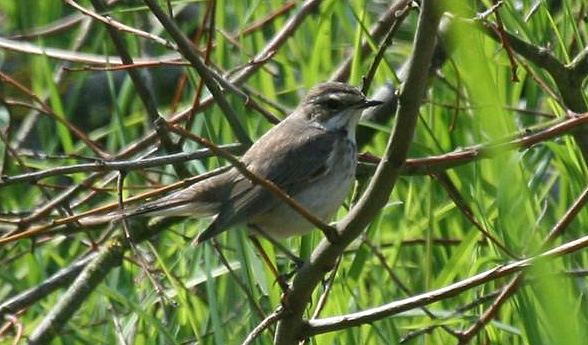
May is typically quiet, with sudden bursts of activity - and this year was no exception. A first year female Bluethroat which turned up on the 25th at Leasowe Lighthouse was no doubt the star bird of the month. It was still present early the next day when a Nightingale was on Hilbre. There were two particularly good days apart from that, the 21st saw a Red Kite at Leasowe Lighthouse and a Black Kite over the Connah's Quay reserve, as well as a Cuckoo and an Osprey. The following day brought a Lapland Bunting and Turtle Dove to Red Rocks.
The spring migration was still well underway early in the month with 103 Whimbrel at Heswall and eight Spotted Redshank at Inner Marsh Farm on the 1st. A few Whinchats trickled through, as did some late Wheatears.
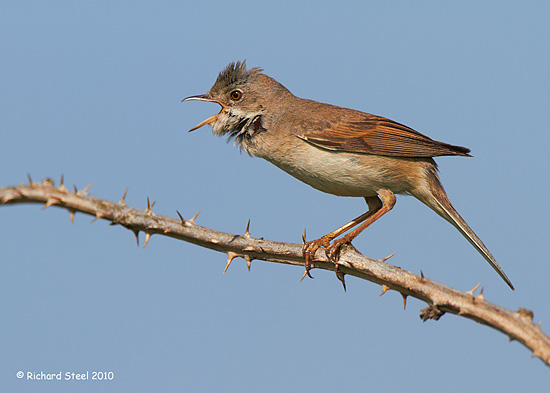
May is a good time to see waders in breeding plumage - this year included a Golden Plover on Hilbre and a male Ruff and two Curlew Sandpiper at Inner Marsh Farm, as well as Sanderlings, Knots, Dunlin and Grey Plovers - all looking very distinguished in their summer plumage!
Out to sea there were the usual Gannets plus a couple of Arctic Skuas on the 8th, but the strong west wind on the 30th was particularly good with 575 Gannets, 250 Common Tern, 7 Fulmars and 33 Manx Shearwaters off Hilbre.
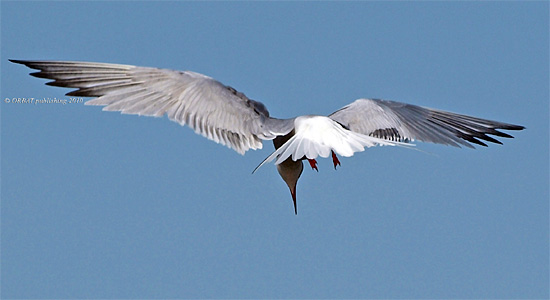
The Little Terns are back breeding at Gronant in good numbers, more details next month, but unfortunately the Common Terns deserted their colony at Shotton again after first turning up in good numbers. It appears that shortage of food in the inner estuary is the problem although that has still to be established for definite.
Richard Smith.
What to expect in June
June is not as quiet as some birders think! Given some strong westerly winds sea-watching can be great with plenty of Manx Shearwaters and Gannets, and the likelihood of Storm Petrels and Arctic Skuas. The Little Terns at Gronant will get down to some serious egg-laying by the first week of June, we expect at least 100 pairs there this year.
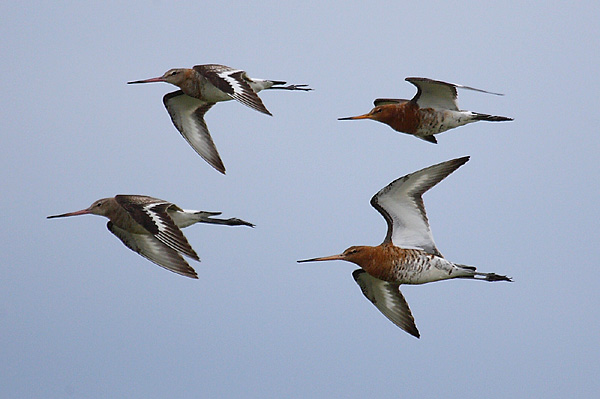
Look out for over summering waders including flocks of Knot out on the estuary, these will be non-breeding immature birds. We can also get a few Knot at Inner Marsh Farm along with several hundred Black-tailed Godwits. By the end of the month the first returning waders will have arrived with Spotted Redshanks and Green Sandpipers, they prefer fresh water sites so Inner Marsh Farm is a prime spot for these, but keep an eye out for the former at Connah's Quay and the latter at Gilroy Nature Park. Of the commoner waders Curlew are usually back on the estuary in good numbers this month, Heswall and Thurstaston is a favourite spot for these.
Hobbies have been increasing over the past few years, Burton is a good place to see these small raptors but they can turn up just about anywhere - I've seen them both at Gilroy Nature Park and Gronant in recent years. We might get a wandering non-breeding Osprey coming through, and maybe a Marsh Harrier.
June can spring a surprise or two when it comes to rarities - last June we had a Paddyfield Warbler on Hilbre, and it was June a few years ago when a Black Lark turned up not too far away on Anglesey.
Forthcoming Events
June Highest Spring Tides (Liverpool)
Also see
Tides page.
14th June, 13.12hrs (BST), 9.1m.
15th June, 14.00hrs (BST), 9.1m.
Forthcoming Events
Organised by the
Wirral Ranger Service ,
Flintshire Countryside Service and/or the RSPB:
All these events and walks have bird interest, even those not advertised
specifically for birdwatching. No need to book for these events unless
specified - please check below.
Also see 'Wingspan', a Diary of Birdwatching
Events for Wirral and the North Wales Coast.
Saturday 5th June,
Wild Flower Walk – a 2010 Explore Wirral’s Biodiversity event, 10am–12noon.
Join the Rangers and members of the Wirral Country Park Recording Group
to explore the Wirral Way and its wonderful wildflowers including some
special
orchids. As well as seeking out the flowers we will start to list and map
them
so we can better protect these hedgerow gems. Come along and lend a hand!
No need to book, meet at the Wirral Country Park Visitor Centre.
Ring
0151 648 4371 for info.
Sunday 6th June, Raptor Rescue, 10am – 4pm.
Join us at the Wirral Country Park Visitor Centre and feast your eyes
on
these magnificent birds of prey. Raptor Rescue is a dedicated
organisation
for the rehabilitation of birds of prey. Information and displays
throughout the
day and goods on sale to raise funds. Sorry no dogs.
Ring
0151 648 4371 for info.
Sunday 6th June,
Orchid Walk, 2pm start.
Join us on a peaceful stroll and a fantastic opportunity to see and learn
about
the orchids, wildflowers and much more at RSPB Inner Marsh Farm. £3 nonmembers,
£2 members, pre-booking is essential.
Ring
0151 336 7681.
Saturday 13th June,
Dragons and Damsels, 10am start.
Burton Mere is home to a rare winged mini-beast – the Red-eyed Damselfly
-
join the RSPB as we go in search of it and others as we also explore the
wetland areas around Inner Marsh Farm. £3 non-members, £2 members and
pre-booking is essential.
Ring
0151 336 7681.
Saturday 19th June, Down on the Farm – a
2010 Explore Wirral’s Biodiversity event, 2.30pm – 4.30pm.
Join the Rangers and members of the WCP Recording Group for a walk along
the Wirral Way and through the Dungeon, looking at the wildlife of the
adjacent farmland. We’ll finish at Church Farm for a talk on organic
farming and a spot of afternoon tea. Booking is essential and there is an
advance charge of £5 for this event. Ring 0151 648 4371.
Saturday 26th June, Burton Mere Walk - RSPB.
A free
guided walk around the newly acquired grounds at the site of the Burton
Mere Fishery. Find out about The
RSPB’s plans for the area and the creation of new habitat and visitor
facilities on the Dee Estuary Nature Reserve. Booking is essential, call
0151 336 7681 to book and for further details.
|
 |
The blank (UK) Birding Webring is a collection of quality birding web sites that are based in the United Kingdom. Visit the webring homepage for more information, or A complete list of all the sites in the webring is available by clicking here. previous site in ring : random site in ring : next site in ring |